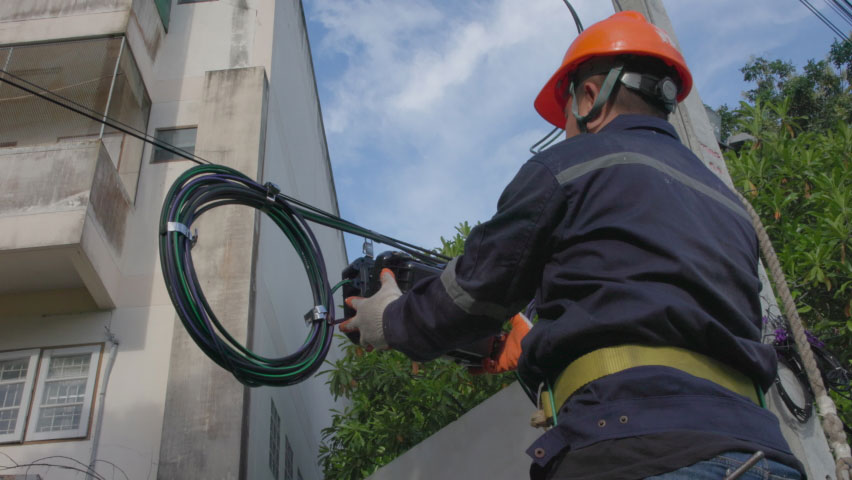How POTN and Fiber Optics Transform Network Efficiency

A Packet Optical Transport Network (POTN) is a next-generation network architecture integrating two of the most powerful network paradigms: a Packet Transport Network (PTN) and an Optical Transport Network (OTN). By leveraging the best aspects of packet-based data management with the speed and capacity of optical transmission, a POTN architecture incorporates network structures capable of efficiently supporting today’s high data demands.
At the highest level, a PO (POTN works as an abstraction) has PTN capability to provide packet transport, with the flexibility and efficiency associated with managing and switching packets, but also has an OTN service layer to move large amounts of data efficiently and reliably across a glossy presentation medium (optical fibers). This hybrid design allows the network to accommodate many types of traffic while efficiently handling packets assigned to streams, whether they’re legacy TDM (time division multiplex) streams or Ethernet packets.
POTN Fundamentals: Architecture and Key Technologies
There are key technologies enabling the type of performance relative to a POTN application. Wavelength Division Multiplexing (WDM) allows multiple optical signals to be sent simultaneously on one fiber at different wavelengths, thereby increasing the bandwidth available for service. Reconfigurable Optical Add-Drop Multiplexers (ROADMs) make wavelength routing efficient by allowing wavelengths to be routed/disaggregated automatically, needing no intervention of a human to change. It is switching Ethernet packets local to the network that completes the Packet Transport notion, and not only that, but TDM/ODU (Optical Data Unit) switching is used to support legacy services as well as various types of Ethernet service or provide simple switching solutions where needed.
While these technologies provide a progressively high capacity means to transport packets across multiple types of switches and provide low latency, they are not in themselves sufficient to afford the operational efficiency of a packet optical transport paradigm. Fiber optic components (infrastructure) are required and crucial for the efficiencies needed for a POTN design—such as optical splitters used to distribute an optical signal to multiple paths, or the specific grade of fiber optic cable and installation needed to achieve high bandwidth with low loss over long distances. Similarly, adapters and connectors provide a portable function of low reflection when connecting cable segments, especially if used repeatedly. Finally, media converters are important in bridging media types, like converting electrical Ethernet signals back to optical to allow for interruptions in networks or to integrate legacy or current equipment within the same network architecture.
Upon closer look, all of these junctions to bridge or move data from packets, to transmit packets, or to disaggregate packets come together to form a flexible, scalable, and high-performance network. A Packet Optical Transport Network forms a packet layer and an optical layer to quickly and efficiently maximize bandwidth, reduce latency, and support many types of data centric services needing transmission, including the transport of voice, video, audio, etc. Therefore, Packet Optical Transport Networking is simply the future of the next generation network architecture paradigm.

POTN vs. Traditional Network Architectures
| Feature | POTN | Traditional Networks | Benefits of POTN |
| Bandwidth Utilization | Dynamic allocation via packet switching | Fixed bandwidth allocation | Higher efficiency, less bandwidth waste |
| Latency | Low latency due to optical transport | Higher latency with multiple network layers | Better support for real-time applications |
| Scalability | Modular, easy to expand | Complex and costly upgrades | Future-proof and flexible network growth |
| Network Complexity | Converged packet and optical layers | Multiple separate layers | Simplified network management |
| Cost Efficiency | Reduced CAPEX and OPEX | Higher operational and capital costs | Lower total cost of ownership |
Traditional networks frequently use fixed bandwidth allocation, resulting in inefficient use of resources, while POTN provides dynamic bandwidth allocation, enhancing overall use of available bandwidth. The optical transport layer associated with POTN also minimizes latency compared to traditional multi layered networks, making it advantageous for real-time applications. POTN’s modular approach provides feasible scalability with no complex upgrades, simply purchasing additional bandwidth. By converging packet and optical layers, POTN increases simplicity by reducing costs, including both capital and OPEX, which equals lower total cost of ownership.
Key Fiber Optic Products Supporting POTN
| Product Category | Description | Role in POTN Network | Example Use Case |
| Fusion Splicers | Precision tools for joining fibers | Ensure low-loss, high-integrity fiber connections | Data center fiber backbone |
| Fiber Optic Cables | Single-mode and multi-mode cables | Provide high-speed, long-distance data transmission | Long-haul and metro networks |
| Media Converters | Devices converting signals between media types | Integrate Ethernet traffic into optical transport | Enterprise LAN to WAN connections |
| Optical Splitters | Devices that divide optical signals | Enable Wavelength Division Multiplexing (WDM) and flexible routing | ROADM-enabled dynamic networks |
| Industrial Ethernet Cables | Ruggedized cables designed for harsh environments | Maintain reliable connectivity in industrial POTN setups | Factory automation networks |
These components are essential to POTN’s success. Fusion splicers are instrumental in establishing fiber connections that ensure no loss of signal quality. Fiber optic cables serve as the high-speed transmission component of the system. Media converters allow transitions between Ethernet and optical layers. Optical splitters provide sophisticated wavelength management. Additionally, industrial Ethernet cables offer connectivity in harsh industrial environments.

Example Applications
POTN and fiber optics are relevant across all sectors:
- Telecom– Backbone networks with high capacity use fiber and ROADMs to provide flexible, scalable bandwidth to support increasing data demand.
- Data Centers– Fusion splicers and media converters support efficient and low-latency exchange of data between servers and storage to guarantee high reliability.
- Industrial Automation– Ruggedized industrial Ethernet cables support POTN infrastructure even in extreme factory environments with stable connectivity.
- Healthcare & Financial– Secure fiber links facilitate transmission of sensitive data with low latency to provide integrity for these sectors.
| Industry | Key POTN Products Used | Primary Benefits |
| Telecom | Fiber optic cables, ROADMs | High bandwidth, scalability |
| Data Centers | Fusion splicers, media converters | Low latency, high reliability |
| Industrial | Industrial Ethernet cables, rugged connectors | Durability, stable connectivity |
| Healthcare/Finance | Secure fiber optic links, low latency | Data integrity, fast transmission |
Installation and Maintenance Best Practices
When deploying a passive optical transport network (POTN), concentration on precision tools (fusion splicers, fiber optic cleavers, testers) is required to increase reliability and quality. Proper handling, as well as commissioning the cable and the installed connector properly, can mitigate signal degradation due to bending or contamination at the connection. Routine inspections and cleaning of connectors and monitoring of signal quality and other metrics will establish a level of health maintenance that will sustain long-term viability and performance. With proper network management tools, diagnostics can be performed proactively to mitigate downtime due to fiber performance issues.

How to Choose the Right Fiber Optic Products for Your POTN Deployment
The selection of fiber optic products required or offered for your POTN deployment will vary, based primarily on the type of cable required for your deployment and what connectors will be compatible with that cable and environmental conditions of installation. Single mode cables are preferred in applications that employ long distances for traffic. Industrial Ethernet cables are a better design for ruggedness required in harsh environments. OEM/ODM product customization and technical support to help in selection from fiberoptic.is can assist in tailored solutions and compliance with standards. The selection of media converters, connectors, and specific cables is needed to ensure seamless access to the network while increasing network reliability.
Conclusion
The use of a passive optical transport network (POTN) and fiber optic technology demonstrates the potential to transform network efficiency through a combination of packet flexibility with the massive speed and capacity of optics. The wide variety of high quality fiber optic products, for example fusion splicers, are exactly the products you will need to deliver on the promises made with your POTN to create a cost-effective, scalable, low latency network. The transition to an integrated POTN solution combined with fiber optic products is paramount in building a resilient communication infrastructure today and into the future to accommodate digital demands.
